When your pond is filled with muck; It’s difficult to enjoy the water feature, especially if you would like to use it for swimming. Muck can have many detrimental effects on your pond; besides just being gross. Luckily, there are some great techniques for reducing and eliminating muck in your lake or pond.
First off: What is Muck?

Pond muck, pond sludge, or pond gunk are simply common names for organic sediment. Muck is a mixture of nutrients from plant matter, algae, dead animals, animal waste, and pollutants. These substances slowly decompose over time to become sediment. This sediment may look like solid ground, when it in fact is not. It may also be spread throughout the water column, causing the water to look murky, cloudy, or dirty.
The accumulation of muck is a completely natural part of the eutrophication process in which an oligotrophic lake becomes a eutrophic lake. In nature, this process takes hundreds or even thousands of years. Today, this process is sped up via runoff of fertilizers and pollutants, which is why ponds may accumulate muck at an incredible rate.
How does muck buildup affect ponds and lakes?
Although muck buildup is a completely natural process, it causes numerous interconnected issues that diminish the ability of pond owners to enjoy their beloved water feature.
Low oxygen levels: Muck buildup contributes to low dissolved oxygen (DO) levels, which is the main contributing factor of the issues that make some lakes unpleasant to be around. Oxygen is needed by fish and other aquatic animals in order to survive and thrive, at low oxygen levels, fish kills occur often. Some organisms produce harmful gases in the absence of oxygen, such as methane and hydrogen sulfide, which are toxic to some organisms and cause extremely foul odors.
Increased nutrient release: Muck is composed almost entirely of nutrients, and any disruption to the water body can cause the muck to be spread throughout the water column, making these nutrients available to algae, thus increasing the abundance of algae (giving the water an off-putting green tint) and the likelihood of a harmful algal bloom.
Eutrophication: The release of nutrients into the water column and
the decrease in dissolved oxygen levels also contributes to the process of
eutrophication, in which a “young” oligotrophic lake, characterized by crystal clear water, high oxygen levels, and a hard bottom, is transformed into a eutrophic lake.

Eutrophic lakes have extremely low DO, which is a breeding ground for aquatic plants and algae. Eutrophic lakes also have an increased ability to produce muck due to their characteristically high amount of plant life and ability to anaerobically decompose organic material
How to get rid of muck in your pond or lake?
There are a few options when if comes to removing the muck from your pond. These include physical, chemical, and natural/chemical-free means.
Physical

Dredging, in which muck is removed using specialized heavy machinery, is a large scale method for muck reduction. Dredging can be extremely expensive, but may be worth considering if your lake is heavily damaged by a thick layer of muck. A small scale method of dredging is the pond rake, which is affordable but requires intense manual labor and may be somewhat ineffective for removing thick layers of muck.
These methods are far from a permanent solution, as muck will return year after year, needing to be removed repeatedly to prevent buildup, which can become quite expensive. These methods also disturb the water, mixing settled nutrients throughout the water column and feeding algal blooms.
Barriers are a semi-permanent method for muck prevention, but are not practical in most situations (usually only fit for extremely large bodies of water) and are very costly.
Chemical-based
Use of chemicals for muck removal is extremely damaging to the pond environment. Enzymes may be used to break down organic matter, but this is somewhat ineffective and harmful to the environment. Herbicides and algaecides can be used to prevent the growth of plant matter which would decompose and become muck, but these chemicals are only useful for prevention of muck formation, rather than muck removal, and must be employed carefully to prevent environmental damage.
Chemical-Free/Natural
Low dissolved oxygen (DO) level is the leading factor contributing to muck formation. As such, aeration is one of the best methods for preventing muck formation and reducing the muck layer. Another natural means is the addition of muck-digesting bacteria.

The leading method for increasing DO is through installing Nanobubble Generators, which have no negative impact on the environment. Nanobubble generators inject tiny bubbles of oxygen (nanobubbles) into the water column. These bubbles are less than 200 nanometers in diameter, 5000x smaller than a grain of sand. Due to their size, they are neutrally buoyant. When nanobubbles come into contact with harmful compounds in the water column, these compounds are oxidized and rise to the surface. Due to their small size and neutral buoyancy, Nanobubbles have an 85% oxygen transfer efficiency, increasing the DO of a waterbody at an incredible rate when compared to traditional aerators (1-20% depending on the type of aerator).
A high DO level increases the activity of aerobic bacteria that digest nutrients in the muck layer and throughout the water column. When a nanobubble generator is used in conjunction with beneficial bacteria treatments, the muck layer in a pond can be reduced by up to 2 inches per month.
Need help removing muck? Contact us today
Lake Restore can help with any lake or pond problems that you are facing. If you have any questions about improving your pond or lake, we are here to help you personally determine the best course of action for your pond or lake. Click here to contact a surface water specialist or navigate to the contact page on our website. Our surface water specialists love helping people restore the natural beauty of their lake or pond.


